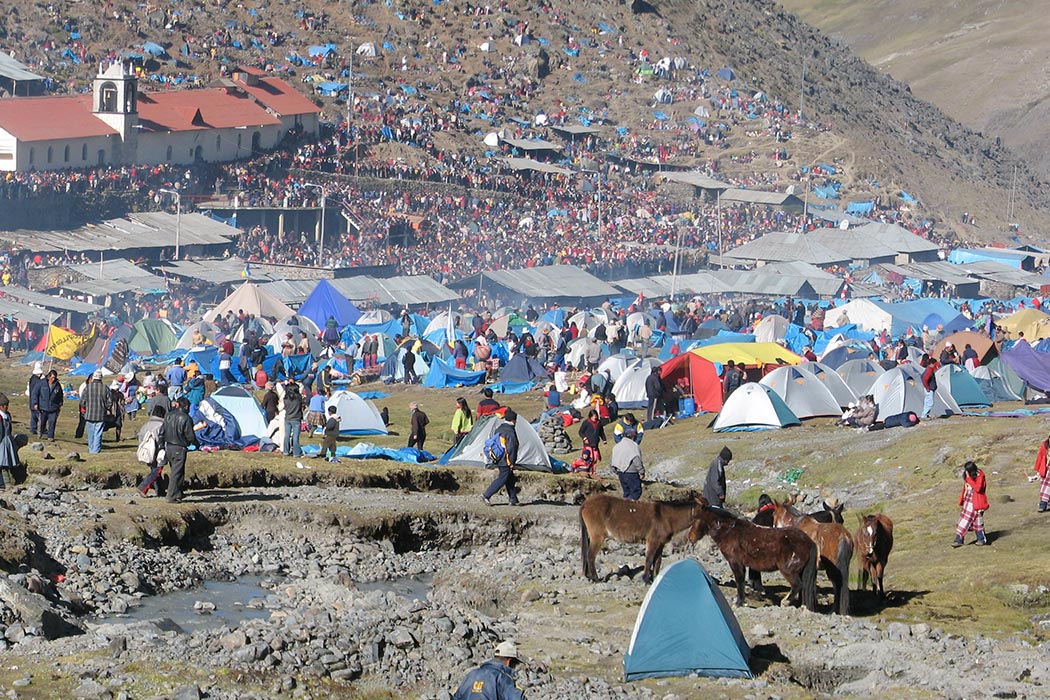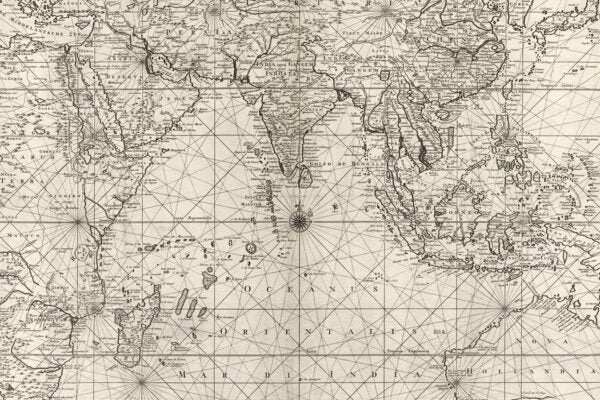In the Andean mountains of Peru, more than 15,000 feet above the surface of the earth, the Qulqipunku glacier clings to the mountainside looming over the Sinakara Valley. The icy tower, and the mountain it rests on, are the center of a sacred annual event, the Quyllurit’i, where tens of thousands of pilgrims gather to celebrate the Christ of the Snow Star. Located several hours east and a mile higher than the city of Cuzco, the site includes a shrine managed by the Brotherhood of Quyllurit’i–and little else.
Every year around the end of May or the beginning of June, the valley swells with travelers making the pilgrimage, carrying tents and food on their backs, or on donkeys and horses. Many come from indigenous villages in the mountains, while others are urban-dwelling, Spanish-speaking mestizos who make the trek from nearby cities. More recently, the native pilgrims have been joined by foreign tourists, some who simply want to witness the spectacle, others searching for enlightenment. All must battle the frigid temperatures and stiflingly high altitude in order to reach the valley where the festivities occur.
The myth behind the celebration claims that an indigenous boy herding llamas came upon a white boy, whom he befriended. Over the course of their friendship, the boy’s herd of llamas experienced a miraculous growth, and the white boy eventually turned into a shining light in which the image of a crucified Christ over a tree became visible. When the indigenous boy died, he was buried in front of a large rock on which an image of crucified Christ was painted.
Despite the heavy Catholic themes of the shrine, it reflects many of the native Andean mythologies as well, including the close association with rocks that represent legendary personages. In addition to worshipping the figure of Christ, Peruvians come to worship the apus, or mountain gods, and Pachamama, the earth mother. There is no tension in the apparent contradictions between worshipping Christ and worshipping the environment. As one Peruvian scholar, Guillermo Salas Carreño, writes, “Pilgrimage is a ritual that challenges canonical practices and dogmas of churches, which attempt to centralize authority and to impose a doctrine through professional priesthoods and routinization of practices.”
Indeed, despite the presence of the Jesuit priests, who maintain the church and shrine year round, the Quyllurit’i is anything but a staid, solemn affair. Members of small towns and villages travel from near and far in groups called “nations,” bringing with them their own miniature icon of Christ or Mary to set next to the shrine overnight. Many of them bring musical instruments or wear colorful costumes. They perform choreographed dances and sing their own songs over the course of the celebration.
Among the dancers are the ukuku, dressed in shaggy brown-and-yellow outfits and carrying whips and meant to symbolize half-human half-bear creatures. These men speak in high-pitched voices, offering jokes, insults, and the occasional sexual innuendo as they cavort around the crowds. They represent the Andean trickster, an intermediary between the gods and the humans. On the evening before the festival begins, these dancing ukukus lead a procession up the glacier in the moonlight. They stay there overnight to pray and worship, then stream down in the morning, a cascade of kinetic energy and bright colors. The noise and bodies are disorganized, all following the path of their own nations. But instead of transforming into a chaotic melee, the dancers and musicians and pilgrims give way to a “harmonious celebration,” as one traveler describes it.
The journey to the shrine can be an arduous one, both because of the cost of buying food to feed all the members of a village and because of the geography. For those not raised in the Andes, the hike up the mountain at high altitude can feel insurmountable. Yet people return, year after year. Every pilgrim, indigenous or foreign, comes for different reasons: in penance for previous sins; to supplicate to the sacred deities for a favor, be it financial prosperity or physical health; or in fulfillment of a vow to make the journey after having an earlier request granted. Whatever their personal reasons for making the journey, many are attracted by what the pilgrimage represents–an annual recognition of wonder and awe.
Underlying all of these reasons, however, might be another, more intangible goal–the search for enlightenment. As one religious scholar wrote, pilgrimages of all natures are “a search through a dark and unknown territory for one’s essential self.”







